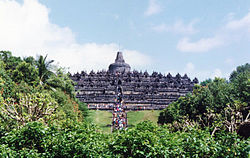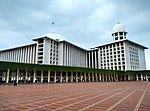Kyai

| Part of a series on |
| Religion ofJava |
|---|
 |
Akyai(/kjaɪ/KYEYE) is an expert inIslam.This denomination is usually used among the ethnicJavanese people.
Origins
[edit]The wordkyaiis ofJavaneseorigin. Sometimes it is spelledkiai.Traditionally, students ofIslam in Indonesiawould study in a boarding school known as apesantren.As a form of respect, the leader of the school was referred to as kyai. The traditional word for a teacher in Islam isustad,which is aPersianword. There are many ustads in Indonesia who teach the religion.
Education
[edit]Kiai were educated in variouspesantren:
Highly motivated students went from pesantren to pesantren, studying in each the texts in which its kiai was specialised. After a few pesantrens in Banten, they would go on to pesantrens in Bogor, Cianjur, Cirebon, Central or East Java and finally, if their families could afford it, to Mecca, the most prestigious centre of Islamic learning.[1]
A student in a pesantren is called asantri.After the founding kyai of a pesantren dies, his son or another santri may take over the supervision of the school, and would then be called kyai. It is possible for a large boarding school to have several kyai living and teaching there.[2]However, most pesantren have a few hundred students, with only one person who is called kyai. The other teachers in the school are called ustadz. Many Indonesian Muslims consider a kyai to be higher ranked than an ustadz because a kyai runs his own boarding school and has mystical abilities.[3]
Function
[edit]Kiai were distinct from thepangulu,the state officials:
The pesantrens were typically (although not uniquely) located in rural districts, away from the major roads. Their geographical isolation symbolised, as it were, their ideological distance from the state. Thepangulu,as a state official, and the independent teacher, thekiai,were two contrasting types, in Banten as well as elsewhere in Java. "[1]
A kyai is not aclericin the same way as apriestinChristianityorBuddhism.There is no governing body that ordains or authorizes a kyai. Likewise, no organization can defrock a kyai or remove him from his position. The reason is that a kyai has his position and authority because people will listen to what he says.[4]
Some Indonesians refer to a widely regarded kyai as anulama.This word is actually the plural form of theArabicwordalimwhich means knowledgeable person. Through common usage in Indonesia, the wordulamagrew to signify a high-level kyai, even though this is a grammatical misuse of the Arabic word.[2]
In legend, if not in fact, a kyai combines the skills and roles of both the Islamic scholar and the Sufi master (sheikhorsyehk). Stories abound about kyai that can perform such feats as:[3]
- Fly to Mecca for mid-day prayers and be back in the pesantren for the afternoon repast;
- Walk through the rain without getting wet;
- Meditate by the ocean until the waves stop moving;
- Heal the sick;
- Have secret knowledge about someone that can help that person solve personal problems.
Other uses
[edit]Heirloom items
[edit]Kyai is also a common honorific for important heirloom items inkratonsin Java, like gamelan, chariot, andkris.For example,gamelanused in annualGrebegcelebration inYogyakartais calledKyai Sekati,itself divided into two instrumental sets:Kyai GunturmaduandKyai Nagawilaga.[5]Meanwhile, Yogyakarta's royal chariot of is calledKyai Garudayaksa.[6][7]
Wali Songo
[edit]In some parts of Indonesia, famous students of theWali Songomystics are referred to historically as kyai or kiai orki.One of them, Ki Ageng Gribig, is said to have returned fromMeccawith a small kind of pastry which did not spoil during the long journey. To commemorate this feat, the people ofJatinomhold a festival each year, wherein thousands of these little cakes (called apem) are blessed and tossed out to participants. The main road fromKlatentoBoyolaliinCentral Java,which passes through the town of Jatinom, is officially named after Ki Ageng Gribig, though known colloquially as Jalan Boyolali (Boyolali Road).
References
[edit]- ^abBruinessen 1995.
- ^abZamakhsyari Dhofier The Pesantren Tradition: A Study of the Role of the Kyai in the Maintenance of the Traditional Ideology of Islam in Java Tempe, AZ: Arizona State University Program for Southeast Asian Studies Monograph Series.
- ^abRonald Lukens-Bull 2005 A Peaceful Jihad: Negotiating Identity and Modernity in Muslim Java. New York: Palgrave Macmillan. Pp. 97-99.
- ^Ronald Lukens-Bull 2005 A Peaceful Jihad: Negotiating Identity and Modernity in Muslim Java. New York: Palgrave Macmillan. Pp. 96-97.
- ^Platvoet, Jan; K. van der Toorn (1995).Pluralism and identity: studies in ritual behaviour.BRILL. p. 261.ISBN978-90-04-10373-3.ISBN90-04-10373-2.
- ^"Kereta Premili - Premili chariot".Flickr. 20 September 2010.
- ^"Kereta Kangjeng Kyai Garudayaksa".Museum Ratawijayan. Archived fromthe originalon 2014-05-02.Retrieved2011-04-07.
Sources
[edit]- Bruinessen, Martin van (1995)."Shari'a court, tarekat and pesantren: religious institutions in the sultanate of Banten".Archipel.50:165–200.doi:10.3406/arch.1995.3069.Archived fromthe originalon 2009-10-26.

